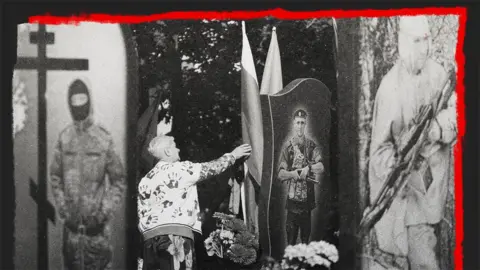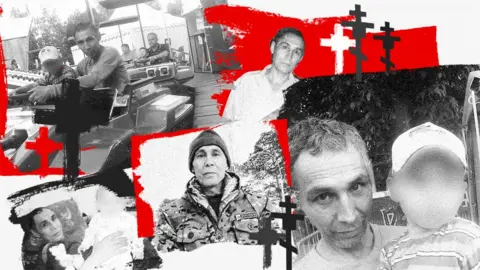
 Getty Images
Getty Images
More than 70,000 people fighting in Russia’s military have now died in Ukraine, according to data analysed by the BBC.
And for the first time, volunteers - civilians who joined the armed forces after the start of the war - now make up the highest number of people killed on the battlefield since Russia’s full-scale invasion began in 2022.
Every day, the names of those killed in Ukraine, their obituaries and photographs from their funerals are published across Russia in the media and on social networks.
BBC Russian and the independent website Mediazona have collated these names, along with names from other open sources, including official reports.
We checked that the information had been shared by authorities or relatives of the deceased - and that they had been identified as dying in the war.
New graves in cemeteries have also helped provide the names of soldiers killed in Ukraine - these are usually marked by flags and wreaths sent by the defence ministry.
We have identified the names of 70,112 Russian soldiers killed in Ukraine, but the actual number is believed to be considerably higher. Some families do not share details of their relatives’ deaths publicly - and our analysis does not include names we were unable to check, or the deaths of militia in Russian-occupied Donetsk and Luhansk in eastern Ukraine.
Among them, 13,781 were volunteers - about 20% - and fatalities among volunteers now exceed other categories. Former prisoners, who joined up in return for pardons for their crimes, were previously the highest but they now account for 19% of all confirmed deaths. Mobilised soldiers - citizens called up to fight - account for 13%.
Since October last year, weekly fatalities of volunteers have not dipped below 100 - and, in some weeks, we have recorded more than 310 volunteer deaths.
As for Ukraine - it rarely comments on the scale of its deaths on the battlefield. In February, its president, Volodymyr Zelensky, said 31,000 Ukrainian soldiers had been killed, but estimates based on US intelligence suggest greater losses.
The story of Rinat Khusniyarov is typical of many of the volunteer soldiers who died. He was from Ufa in Bashkortostan and had been working two jobs to make ends meet - at a tram depot and a plywood factory. He was 62 years old when he signed his contract with the Russian army in November last year.
He survived less than three months of fighting and was killed on 27 February. His obituary, in a local online memorial website, simply called him “a hardworking, decent man”.

 Rinat Khusniyarov via ok.ru
Rinat Khusniyarov via ok.ru
Rinat Khusniyarov signed up to fight at the age of 62
According to the data we analysed, most of the men signing up come from small towns in parts of Russia where stable, well-paid work is hard to find.
Most appear to have joined up willingly, although some in the republic of Chechnya have told human rights activists and lawyers of coercion and threats.
Some of the volunteers have said they did not understand the contracts they were signing had no end date, and have since approached pro-Kremlin journalists to, unsuccessfully, ask them for help ending their service.
Salaries in the military can be five to seven times higher than average wages in less affluent parts of the country, plus soldiers get social benefits, including free childcare and tax breaks. One-off payments for people who sign up have also repeatedly risen in value in many parts of Russia.
Most of the volunteers dying at the front are aged between 42 and 50. They number 4,100 men in our list of more than 13,000 volunteers. The oldest volunteer killed was 71 years old - a total of 250 volunteers above the age of 60 have died in the war.
Soldiers have told the BBC that rising casualties among volunteers are, in part, down to their deployment to the most operationally challenging areas on the front line, notably in the Donetsk region in the east, where they form the backbone of reinforcements for depleted units, Russian soldiers told the BBC.
Russia’s “meat grinder” strategy continues unabated, according to Russian soldiers we have spoken to. The term has been used to describe the way Moscow sends waves of soldiers forward relentlessly to try to wear down Ukrainian forces and expose their locations to Russian artillery. Drone footage shared online shows Russian forces attacking Ukrainian positions with little or no equipment or support from artillery or military vehicles.
Sometimes, hundreds of men have been killed on a single day. In recent weeks, the Russian military have made desperate, but unsuccessful, attempts to seize the eastern Ukrainian towns of Chasiv Yar and Pokrovsk with such tactics.
An official study by the primary military medical directorate of the Russian defence ministry says that 39% of soldiers’ deaths are a result of limb injuries and that mortality rates would be significantly improved if first aid and subsequent medical care were better.
The Russian government’s actions suggests it is keen to avoid forcing people to fight through a new, official wave of mobilisation - instead, it is ramping up calls for service volunteers, along with the incentives to do so.
Remarks by regional officials in local parliaments suggest they have been tasked from the top with trying to recruit people from their local districts. They advertise on job vacancy websites, contact men who have debt and bailiff problems, and conduct recruitment campaigns in higher education establishments.
Since 2022, convicted prisoners have also been encouraged to join up in return for their release, but now a new policy means people facing criminal prosecution can accept a deal to go to war instead of facing trial in court. In return, their cases are frozen and potentially dropped altogether.

 Getty Images
Getty Images
A cemetery close to a military airfield outside Taganrog in south-west Russia
A small number of the volunteers killed have been from other countries. We have identified the names of 272 such men, many of whom were from Central Asia - 47 from Uzbekistan, 51 from Tajikistan, and 26 from Kyrgyzstan.
Last year saw reports of Russia recruiting people in Cuba, Iraq, Yemen and Serbia. Foreigners already living in Russia without valid work permits or visas, who agree to “work for the state”, are promised they will not be deported and are offered a simplified route to citizenship if they survive the war. Many have later complained that they did not understand the paperwork - as with Russian citizens, they have turned to the media for help.
The governments of India and Nepal have called on Moscow to stop sending their citizens to Ukraine and repatriate the bodies of the dead. So far, the calls have not been acted upon.
Many new recruits who have joined the military have criticised the training they have received. A man who signed a contract with the Russian army in November last year told the BBC he had been promised two weeks of training at a shooting range before deployment to the front.
"In reality, people were just thrown out onto the parade ground, and dished out some gear,” he said, adding the equipment was poorly made.
“We were loaded on to trains, then trucks, and sent to the front. About half of us were thrown into battle straight from the road. As a result, some people went from the recruitment office to the front line in just a week,” he said.
Samuel Cranny-Evans, an analyst at the Royal United Services Institute in the UK says: “Basic understanding of things like camouflage and concealment or how to move quietly at night, how to move without creating a profile for yourself during the day,” should be taught as basic infantry skills.
Another soldier also told the BBC that equipment is a problem, saying it “varies, but most often it's some random set of uniforms, standard boots that wear out within a day, and a kit bag with a label showing it was made in the mid-20th Century”.
“A random bulletproof vest and a cheap helmet. It's impossible to fight in this. If you want to survive, you have to buy your own equipment.”

 2 hours ago
1
2 hours ago
1










 English (US) ·
English (US) ·